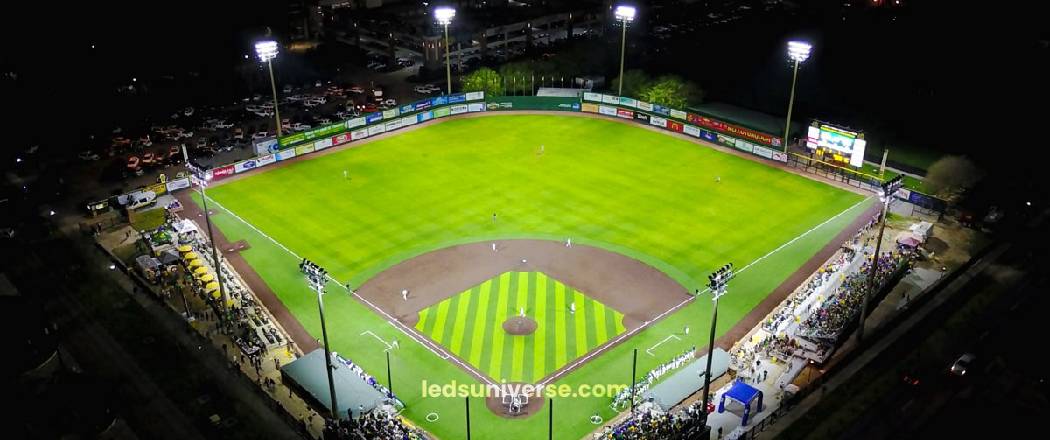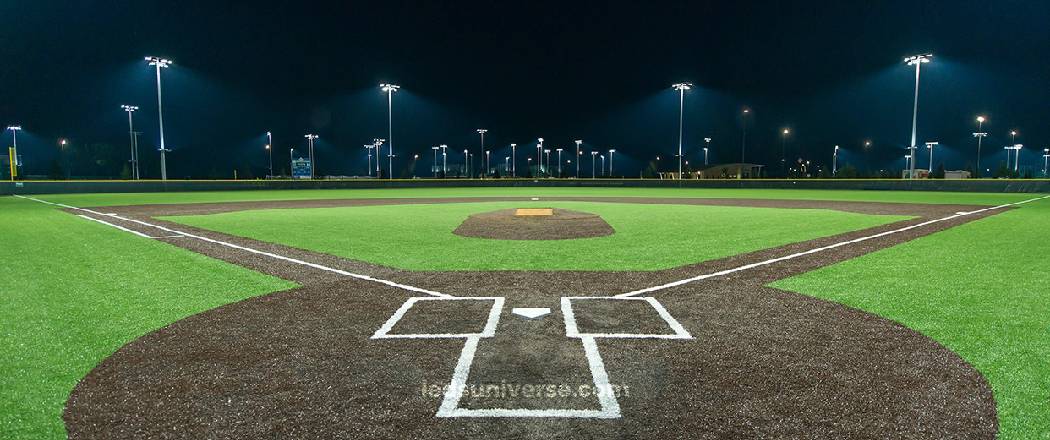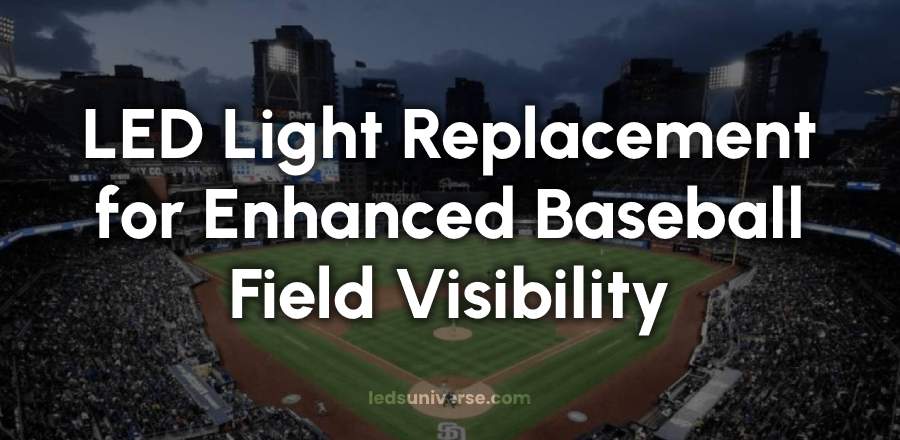As the sun sets and twilight descends, the vibrant buzz of anticipation fills the air at the local baseball field. The crack of a bat and the roar of the crowd echo under the bright, warm glow of state-of-the-art LED lights, transforming the evening into a spectacular showcase of athleticism and community spirit. LED lighting not only enhances visibility for players and spectators but also elevates the overall experience of the game.
Baseball is a game steeped in tradition, where the crack of the bat and the roar of the crowd resonate under the glow of the stadium lights. Upgrading to LED lighting represents a transformative step in enhancing visibility, energy efficiency, and overall performance at baseball fields. We will delve into the advantages of LED light replacement, the considerations involved in the transition, and the various benefits that come with modernizing field lighting.
Table of Contents
ToggleUnderstanding LED Lighting Technology
Light Emitting Diodes (LEDs) have revolutionized the way lighting is utilized across various industries, including sports facilities. Unlike traditional lighting methods, such as incandescent or halogen bulbs, LEDs operate through a semiconductor process that emits light when electricity passes through. This innovative technology provides a multitude of benefits, making it an attractive option for baseball fields.
Efficiency and Longevity
One of the most striking features of LED lighting is its energy efficiency. Compared to traditional lighting solutions, LEDs consume significantly less electricity while providing comparable, if not superior, luminosity. This reduced energy consumption translates into lower utility bills for facility operators. Furthermore, LEDs have an impressive lifespan, often lasting over 25,000 hours. This longevity means less frequent replacements, leading to reduced maintenance costs and downtime for the field.
Quality of Light
Another advantage of LED lighting is the quality of light it provides. LEDs produce a bright, white light that enhances visibility on the field. This is especially beneficial during night games when clear illumination is necessary for players, umpires, and spectators. The uniform distribution of light also minimizes shadows, creating a safer and more enjoyable environment for everyone involved in the game.

Assessing the Need for Replacement
Transitioning to LED lighting is an investment that requires careful consideration. It is essential to assess the current lighting situation on the baseball field and determine the specific needs of the facility. Understanding the limitations of existing lighting systems can help identify areas for improvement.
Evaluating Current Lighting Conditions
Facilities should conduct an evaluation of their current lighting setup, considering factors such as brightness levels, energy consumption, and maintenance requirements. If the existing lighting is outdated, inconsistent, or failing to meet the demands of modern play, the case for LED replacement becomes more compelling. Inadequate lighting can negatively impact game performance and safety, making the need for an upgrade apparent.
Consulting with Professionals
Engaging with lighting professionals can provide valuable insights into the best options available for a baseball field. These experts can conduct comprehensive lighting assessments, recommend suitable LED products, and create a customized plan tailored to the specific needs of the facility. By collaborating with industry professionals, field operators can ensure they make informed decisions throughout the replacement process.
The Replacement Process
Transitioning to LED lighting involves several steps, each of which contributes to the successful implementation of a new lighting system. From planning to installation, understanding the process can help facilitate a smooth transition.
Planning and Design
Once the decision to replace existing lighting with LEDs has been made, the planning stage begins. This phase involves designing a lighting layout that maximizes illumination while adhering to any regulations or guidelines set by local authorities or governing sports organizations. Factors such as pole height, light positioning, and fixture selection all play a role in creating an effective lighting design.
Installation
The installation of LED lighting should be carried out by experienced professionals who understand the technical aspects of lighting systems. Safety is paramount during this process, and adherence to all safety regulations is vital to protect workers and the integrity of the facility. The installation team will replace the existing fixtures with new LED units, ensuring proper alignment and functionality. Testing the system after installation is crucial to verify that the lighting meets the required standards.
Ongoing Maintenance
After the installation is complete, ongoing maintenance is necessary to ensure the LED lighting system continues to operate effectively. Regular inspections and cleaning of fixtures can help maintain optimal performance. Unlike traditional lighting systems that often require frequent bulb replacements, LEDs require less maintenance, allowing facility managers to focus on other operational aspects.
Environmental Impact
The environmental benefits of LED lighting extend beyond energy savings. By reducing electricity consumption, facilities can lower their carbon footprint. The production of electricity is often tied to greenhouse gas emissions, and decreasing energy use contributes to a healthier environment.
Sustainable Practices
Many facilities are adopting sustainable practices, and upgrading to LED lighting aligns perfectly with these initiatives. Facilities can further enhance their sustainability efforts by recycling old lighting fixtures and using energy-efficient technologies throughout the property. This commitment to environmental stewardship can enhance the reputation of the facility within the community.
Compliance with Regulations
As environmental regulations become more stringent, facilities may find themselves needing to adapt to meet compliance standards. Transitioning to LED lighting can help ensure that facilities align with local, state, and federal guidelines regarding energy use and emissions.
Economic Advantages
While the initial investment in LED lighting may seem daunting, the long-term economic benefits often outweigh the costs. From reduced energy bills to lower maintenance expenses, the financial implications of upgrading are noteworthy.
Energy Cost Savings
Facilities can experience significant reductions in energy costs after replacing traditional lighting with LEDs. The lower wattage and higher efficiency translate to decreased utility bills, allowing funds to be redirected toward other areas of facility improvement or community programs.
Increased Usage and Revenue
With improved lighting, baseball fields can accommodate more activities, including games, practices, and community events. This versatility can lead to increased revenue opportunities for the facility. Higher-quality lighting enhances the overall experience for players and spectators, making the field a more attractive option for hosting events.

Enhancing Player and Spectator Experience
The experience of players and spectators is paramount in sports. Quality lighting not only enhances visibility but also contributes to the overall atmosphere of the game.
Improved Player Performance
For players, good lighting conditions can significantly influence performance. Adequate visibility allows players to track the ball more effectively and make informed decisions on the field. This enhancement can lead to better gameplay and increased enjoyment of the sport.
Spectator Comfort and Engagement
Spectators also benefit from improved lighting conditions. Enhanced visibility allows fans to fully engage with the game, fostering a sense of community and excitement. Well-lit fields create a welcoming environment, encouraging families and fans to attend games regularly. This increased attendance can have positive implications for local teams and leagues.
Addressing Common Concerns
Transitioning to LED lighting may raise some questions or concerns among facility operators and stakeholders. Addressing these concerns can help alleviate apprehensions and promote a smooth transition.
Initial Costs
The upfront costs associated with LED lighting replacement can be a concern for many facility operators. However, it is essential to consider the long-term savings that will offset these initial expenses. In many cases, grants or funding opportunities may also be available to assist in covering costs.
Compatibility with Existing Systems
Facility operators may wonder if new LED fixtures will be compatible with existing infrastructure. Consulting with lighting professionals can provide clarity on compatibility issues and ensure that the new system integrates seamlessly with current setups.
Aesthetic Considerations
Aesthetic concerns regarding the appearance of LED fixtures compared to traditional lighting may arise. However, modern LED designs can be sleek and unobtrusive, blending well with the overall aesthetic of the field. The focus should remain on functionality and performance, ensuring that the lighting enhances the experience for everyone involved.
Community Engagement
Upgrading to LED lighting can also foster community engagement and support for local baseball programs. Facilities that invest in their infrastructure often see an increase in community involvement, as residents appreciate the enhancements made to their local fields.
Promoting Local Baseball Programs
Communities benefit from improved baseball fields that attract players and families. Hosting tournaments or events at well-lit facilities can draw larger crowds, encouraging support for local teams and programs. This engagement can foster a sense of pride and camaraderie among residents.
Education and Awareness
As communities adapt to new technologies, educating residents about the benefits of LED lighting can promote awareness and support for future initiatives. Facilities can host informational sessions or collaborate with local schools to raise awareness about sustainability and the advantages of modern lighting.
Conclusion
Upgrading to LED lighting for baseball fields offers a transformative opportunity to enhance the overall experience for players, spectators, and facility operators. With benefits such as energy efficiency, improved visibility, and reduced maintenance costs, the transition aligns with modern standards in sports infrastructure. As communities invest in their local fields, the shift to LED technology not only improves gameplay but also fosters engagement and pride among residents. Embracing these advancements ensures that baseball continues to thrive as a beloved pastime, illuminated by the bright future of modern lighting solutions.
